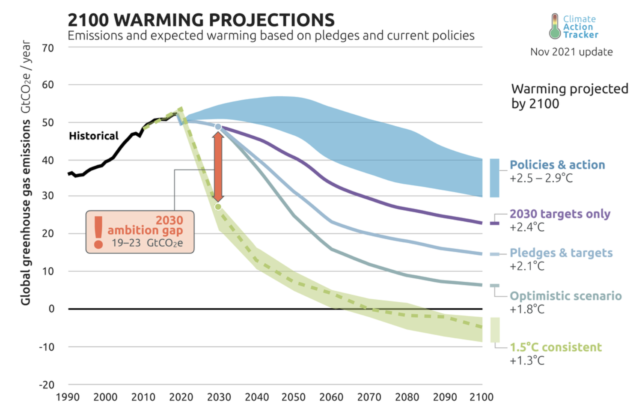After COP26: Why Forests and Soils will be Crucial to Climate Policy

by Anne-Marie Codur and Jonathan Harris
The latest stage in global efforts to respond to climate change was the 26th Conference of the Parties (COP26) to the United Nations Framework Convention on Climate Change, held in Glasgow in November 2021. The conference brought together delegations from 197 countries with the goal of achieving major progress towards implementation of the 2015 Paris Agreement on Climate Change.
Despite progress on climate action at COP26, a substantial gap remains between pledged and needed emissions reductions, as shown in Figure 1 below.
Figure 1: Projections of Global Greenhouse Gases

This gap emphasizes the importance of increasing carbon removal from the atmosphere in addition to reducing emissions. Natural systems including forests, wetlands and soils currently remove about 3 gigatons (Gt) of carbon (33 percent of annual emissions) from the atmosphere, while oceans absorb an additional 2.6 Gt of carbon. In addition to acting as greenhouse gas sinks, ecosystems offer many other services, including biodiversity, freshwater supply, prevention of droughts and floods and prevention of erosion.
Moving forward, enhancing forests and soils as natural climate solutions has great potential to help close the emissions gap and support progress towards global climate goals.
Context and outcomes of COP26
The global context of COP26 was set by the sixth assessment of the Intergovernmental Panel on Climate Change (IPCC), which warned that “global warming of 1.5°C and 2°C will be exceeded during the 21st century unless deep reductions in carbon dioxide (CO2) and other greenhouse gas emissions occur in the coming decades.” Exceeding 1.5°C would significantly increase projected and potentially catastrophic outcomes, including extreme temperatures, heavy precipitation, droughts, tropical cyclones, and reductions in snow cover and permafrost.
Unfortunately, the strengthened commitments to nationally determined contributions (NDCs) announced by the end of COP26 still fall considerably short of the goal. According to Climate Action Tracker, a non-profit scientific organization, there is a large gap between what was committed by the end of COP26 (which would lead to 2.4°C warming) and the commitments needed to put the world on a path to 1.5°C, as shown in Figure 1.
Climate Action Tracker’s analysis indicates that “policies presently in place around the world are projected to result in about 2.7°C warming above pre-industrial levels. NDCs alone will limit warming to 2.4°C. When binding long-term or net-zero targets are included warming would be limited to about 2.1°C.” To reach a 1.5°C pathway, CO2 emissions would need to be at least 20 Gigatons (billion tons, or Gt) less than what they are projected to be in 2030 with current NDCs commitments.
The Glasgow Climate Pact summarizing COP26 outcomes reflects for the first time a specific commitment to “phase down” fossil fuels. The document also calls for the elimination of fossil fuel subsidies and rapidly scaling up the deployment of clean power generation and energy efficiency measures.
COP26 resolved to update NDCs every year, rather than every five years, starting with the next conference, COP27, in 2022. Developed nations reaffirmed their obligation to mobilize $100 billion a year to support climate mitigation efforts in developing countries, and to double funding for climate adaptation to $40 billion by 2025. COP26 also identified a set of rules for the global carbon market under the Paris Agreement’s Article 6, enabling international trading of carbon reduction credits, though important issues remain to be resolved to ensure credits represent real carbon emissions reductions rather than “hot air.”
Other important areas saw agreements among subsets of the participants: a Global Methane Pledge to slash methane emissions by 30 percent by 2030; a pledge to halt and reverse forest loss and land degradation by 2030; commitments to phase out domestic coal, ending new international public support for fossil fuels and redirecting this investment to clean energy. Over 400 financial firms with over $130 trillion in assets committed to aligning their portfolios to net zero by 2030. Over 1,000 cities and local governments joined the Cities Race to Zero to raise climate action to limit global temperature rise to 1.5°C. Major automakers pledged to work toward selling only zero-emission vehicles globally by 2040.
Despite acknowledging the critical importance of natural systems, COP26 made only limited progress towards specific policy actions to promote preservation and expansion of natural ecosystems.
Forests
Scientists have mapped out key ecosystems, especially the carbon-rich forests and peatlands, that humanity cannot afford to destroy if climate catastrophe is to be avoided. These areas store 139 gigatons (Gt) of carbon in trees, plants and soils, which are “irrecoverable”, meaning that natural regeneration would not be able to compensate for their loss by 2050. During the last decade, 4 Gt of this irrecoverable carbon has been released into the atmosphere through wildfire, logging and farming. The major stores of carbon are in forests and peatlands in the Amazon Forest, Russia, the Congo Basin, Canada and Australia.
In terms of biodiversity, the loss of primary forests has immeasurable consequences, as the loss of habitats is the driving force of what has been called the sixth global extinction of species. In terms of carbon storage, old trees store more carbon than 70 percent of logged and replanted forests. “Keeping trees in the ground” is far more effective in terms of carbon storage than replanting young trees that will take decades to store as much carbon as the trees they are replacing.
The term “proforestation,” referring to a deliberate policy of keeping trees in the ground, has been proposed by William Moomaw to capture the value of protecting and expanding forests. Moomaw commented that “the most effective thing that we can do is to allow trees that are already planted, that are already growing, to continue growing to reach their full ecological potential, to store carbon and develop a forest that has its full complement of environmental services.”
At COP26 the Glasgow Declaration on Forests and Land Use, signed by 100 countries representing 85 percent of the world’s forested land, pledged to end deforestation by 2030. But it remains to be seen whether this pledge, and the Global Forest Finance Pledge that accompanies it, are sufficient tools to curb the current trends of deforestation. Ending deforestation by 2030 would make a massive contribution to climate change mitigation, as well as to protecting biodiversity, but as with other areas of the Glasgow Climate Pact, there remains a huge gap between declared goals and actual policy.
Soils
The main carbon sink on earth, soils store about 2,300 Gigatons of carbon, about three times as much as the atmosphere. Although soils have never been a part of mainstream COP discussions, they have received growing attention since COP21 in 2015. An independent international effort, which originated in Paris at COP21, is the 4per1000 initiative for food security and climate, with hundreds of member groups including countries, regions, academic institutions, farmers organizations and NGOs. The name “4 per 1000” derives from the principle that an annual growth rate of 0.4 percent in soil carbon stocks, or 4 parts per thousand per year, in the first 30-40 cm of soil, would significantly reduce the CO2 concentrations in the atmosphere due to human activities.
According to estimates by Rattan Lal, the technical potential of carbon sequestration in the terrestrial biosphere (soils and vegetation) is between 1.45 to 3.44 Gigatons of Carbon per year. By the end of the 21st century, there would be a potential for all planetary soils to absorb 178 Gigatons of carbon, and for all planetary vegetation to absorb an additional 155 Gigatons, which would amount to a total of 333 Gigatons of carbon. This is equivalent to 157 parts-per-million CO2 in the atmosphere.
More soil organic carbon also means more yields: on average, adding 10 tons of organic carbon per hectare of land increases agronomic yield by 400 to 1,000 kg (depending on the type of crop). A global effort to increase soil carbon would thus contribute both to climate stabilization and food security.
Natural climate solutions are key to achieving 1.5°C target
The primary focus of COP26, as of previous COPs, has been the need for drastic greenhouse emissions reductions. But it is increasingly evident that carbon removal from the atmosphere is equally important to achieve a 1.5°C target.
Some attention has been directed to technologies for artificial carbon removal. But while artificial carbon removal technology is expensive and unlikely to prove scalable to the degree necessary, there is a known and huge potential for carbon removal through natural systems, relying on the power of forests, plants, soils and ecosystems to store carbon.
In addition to being the least expensive option for carbon removal, natural climate solutions have many other win-win features, including biodiversity conservation, improving watershed protection and increasing water security, reducing soil erosion and air pollution and improving human nutrition and health. A focus on the need for policies to implement more sweeping natural climate solutions will grow in importance in future COPs, as well as in national policies aiming to achieve net-zero emissions.
*
Never miss an update: Sign up to receive ECI’s newsletter.
